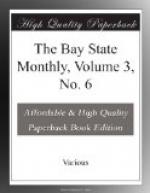[Illustration: OLD STATE HOUSE IN 1801.]
The 29th regiment repaired to the spot prepared for firing, and there would have been a fierce contest but for the excellent conduct of the acting governor, Hutchinson. He took Captain Preston severely to task for firing at the people without the orders of a civil magistrate, and then, quickly working his way to the State House, took his stand in the balcony of the council-chamber looking down King Street, and made an address promising that the law should prevail and justice should be done to all. The next morning Hutchinson was waited upon by the selectmen who informed him that there would be no peace until the soldiers should depart. Hutchinson claimed, however, that the regiments were not under his command.
A mass meeting was soon held in Faneuil Hall, and was addressed by Samuel Adams. It may readily be believed that he advocated no compromise, and a committee of fifteen was immediately appointed of which Adams was a member. According to instructions, they at once repaired to the council chamber, and demanded the instant removal of the troops. At three o’clock a regular town meeting assembled in Faneuil Hall, but, owing to the great number present, adjourned to the Old South Meeting House. Then the committee of fifteen appeared making their way from the council-chamber to the meeting-house. Samuel Adams was at the head, and as the crowd made way on either hand he bared his head, and, inclining to the right and left, as he passed through the line, kept repeating: “Both regiments or none!” “Both regiments or none!”
[Illustration: STATUE IN ADAMS SQUARE.]
In the presence of the dense multitude in the Old South, the governor’s reply was rendered: the 29th regiment should go to the castle, but the 14th must remain. Then the cry arose, “Both regiments or none!” and as the shout echoed from every quarter it was plain that the people had caught the meaning of the watchword, given shortly before by Adams. A new committee, also including Adams, was appointed and sent back to the governor, and as they stood in the council chamber the scene was one that John Adams pronounced long after as worthy a historical painting. A few sentences from Adams’ address to Hutchinson are clear enough to show the intense earnestness and patriotism of the man.




